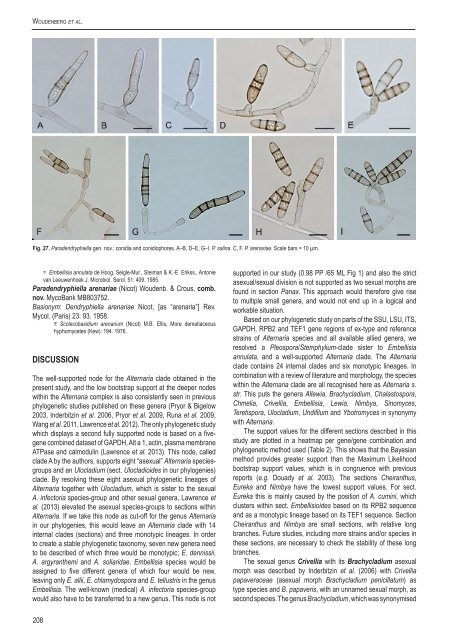Alternaria redefined - CBS - KNAW
Alternaria redefined - CBS - KNAW
Alternaria redefined - CBS - KNAW
Create successful ePaper yourself
Turn your PDF publications into a flip-book with our unique Google optimized e-Paper software.
Woudenberg et al.<br />
Fig. 27. Paradendryphiella gen. nov.: conidia and conidiophores. A–B, D–E, G–I. P. salina. C, F. P. arenariae. Scale bars = 10 µm.<br />
= Embellisia annulata de Hoog, Seigle-Mur., Steiman & K.-E. Erikss., Antonie<br />
van Leeuwenhoek J. Microbiol. Serol. 51: 409. 1985.<br />
Paradendryphiella arenariae (Nicot) Woudenb. & Crous, comb.<br />
nov. MycoBank MB803752.<br />
Basionym: Dendryphiella arenariae Nicot, [as “arenaria”] Rev.<br />
Mycol. (Paris) 23: 93. 1958.<br />
≡ Scolecobasidium arenarium (Nicot) M.B. Ellis, More dematiaceous<br />
hyphomycetes (Kew): 194. 1976.<br />
DISCUSSION<br />
The well-supported node for the <strong>Alternaria</strong> clade obtained in the<br />
present study, and the low bootstrap support at the deeper nodes<br />
within the <strong>Alternaria</strong> complex is also consistently seen in previous<br />
phylogenetic studies published on these genera (Pryor & Bigelow<br />
2003, Inderbitzin et al. 2006, Pryor et al. 2009, Runa et al. 2009,<br />
Wang et al. 2011, Lawrence et al. 2012). The only phylogenetic study<br />
which displays a second fully supported node is based on a fivegene<br />
combined dataset of GAPDH, Alt a 1, actin, plasma membrane<br />
ATPase and calmodulin (Lawrence et al. 2013). This node, called<br />
clade A by the authors, supports eight “asexual” <strong>Alternaria</strong> speciesgroups<br />
and an Ulocladium (sect. Ulocladioides in our phylogenies)<br />
clade. By resolving these eight asexual phylogenetic lineages of<br />
<strong>Alternaria</strong> together with Ulocladium, which is sister to the sexual<br />
A. infectoria species-group and other sexual genera, Lawrence et<br />
al. (2013) elevated the asexual species-groups to sections within<br />
<strong>Alternaria</strong>. If we take this node as cut-off for the genus <strong>Alternaria</strong><br />
in our phylogenies, this would leave an <strong>Alternaria</strong> clade with 14<br />
internal clades (sections) and three monotypic lineages. In order<br />
to create a stable phylogenetic taxonomy, seven new genera need<br />
to be described of which three would be monotypic; E. dennissii,<br />
A. argyranthemi and A. soliaridae. Embellisia species would be<br />
assigned to five different genera of which four would be new,<br />
leaving only E. allii, E. chlamydospora and E. tellustris in the genus<br />
Embellisia. The well-known (medical) A. infectoria species-group<br />
would also have to be transferred to a new genus. This node is not<br />
supported in our study (0.98 PP /65 ML Fig 1) and also the strict<br />
asexual/sexual division is not supported as two sexual morphs are<br />
found in section Panax. This approach would therefore give rise<br />
to multiple small genera, and would not end up in a logical and<br />
workable situation.<br />
Based on our phylogenetic study on parts of the SSU, LSU, ITS,<br />
GAPDH, RPB2 and TEF1 gene regions of ex-type and reference<br />
strains of <strong>Alternaria</strong> species and all available allied genera, we<br />
resolved a Pleospora/Stemphylium-clade sister to Embellisia<br />
annulata, and a well-supported <strong>Alternaria</strong> clade. The <strong>Alternaria</strong><br />
clade contains 24 internal clades and six monotypic lineages. In<br />
combination with a review of literature and morphology, the species<br />
within the <strong>Alternaria</strong> clade are all recognised here as <strong>Alternaria</strong> s.<br />
str. This puts the genera Allewia, Brachycladium, Chalastospora,<br />
Chmelia, Crivellia, Embellisia, Lewia, Nimbya, Sinomyces,<br />
Teretispora, Ulocladium, Undifilum and Ybotromyces in synonymy<br />
with <strong>Alternaria</strong>.<br />
The support values for the different sections described in this<br />
study are plotted in a heatmap per gene/gene combination and<br />
phylogenetic method used (Table 2). This shows that the Bayesian<br />
method provides greater support than the Maximum Likelihood<br />
bootstrap support values, which is in congruence with previous<br />
reports (e.g. Douady et al. 2003). The sections Cheiranthus,<br />
Eureka and Nimbya have the lowest support values. For sect.<br />
Eureka this is mainly caused by the position of A. cumini, which<br />
clusters within sect. Embellisioides based on its RPB2 sequence<br />
and as a monotypic lineage based on its TEF1 sequence. Section<br />
Cheiranthus and Nimbya are small sections, with relative long<br />
branches. Future studies, including more strains and/or species in<br />
these sections, are necessary to check the stability of these long<br />
branches.<br />
The sexual genus Crivellia with its Brachycladium asexual<br />
morph was described by Inderbitzin et al. (2006) with Crivellia<br />
papaveraceae (asexual morph Brachycladium penicillatum) as<br />
type species and B. papaveris, with an unnamed sexual morph, as<br />
second species. The genus Brachycladium, which was synonymised<br />
208

















